Family’s New Style Rises in the Aftermath of a Flood
“After you survive a flood, you do kooky things,” says homeowner Janet McMahen; the basement of her home was filled with water and its first floor had more than 9 inches in it after the disastrous June 2013 floods in Alberta, Canada. Once the floodwaters had receded, homeowners and volunteers got busy in a race against mold, tearing out the walls of homes as quickly as possible. After the sledgehammering in their home was done, McMahen and her husband, Trey Petty, stood in the open space and realized they really liked it.
The small, compartmentalized rooms in their 1928 home were all gone, and the couple saw the potential to design an urban loft look they had loved so much when they lived in New York City. “We realized we had an opportunity,” McMahen says. “We said, ‘If we’re going to stay here for many years, let’s make it exactly what we want.’” With the original details on their first floor wiped out and their furniture ruined, there was no reason not to complete a radical renovation. Besides, planning a few kooky details kept up their spirits while they were displaced from their home.
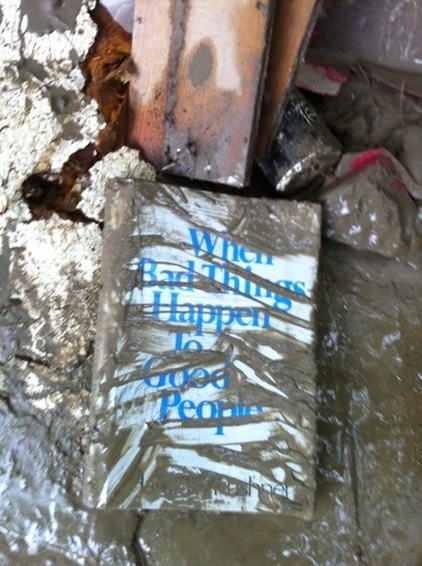
Photos by Rob Moroto, Calgary Photos
Houzz at a Glance
Who lives here: Janet McMahen and Trey Petty, their 5-year-old twin son and daughter, 2 dogs and a cat
Location: Calgary, Alberta, Canada
Size: About 2,600 square feet (241½ square meters); 3 bedrooms, 3 bathrooms
Favorite sources: For reclaimed furniture and architectural salvage, the homeowners used local businesses Uniquities and Reclaimed Trading Company.
“I have a funny relationship with water now,” McMahen says. “Funny” can be taken as meaning “weird” and “funny, ha ha.” McMahen managed to maintain her sense of humor throughout the process, and swears she really found this book of hers in this spot in the yard — a perfect symbol of their experience. “After the flood my neighbor found a book in her yard called Spring Cleaning Made Easy,” she says with a laugh. Her sense of humor certainly helped her family get through the devastation and the extensive renovation.
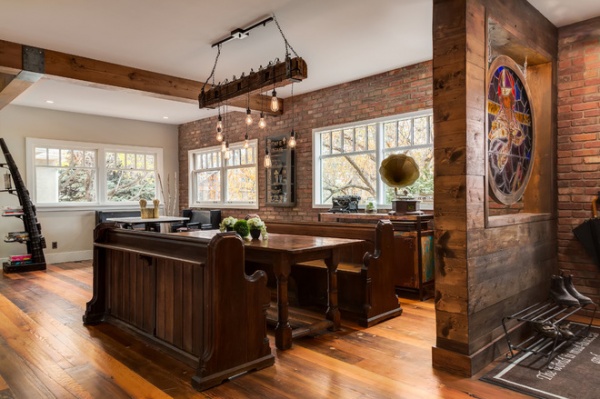
Disgusted by the waste that filled local landfills after the flood, the couple pledged to use as many reclaimed items in their renovation as possible. Working with Riverview Custom Homes, they sourced reclaimed wood to use on their floors, beams, barn doors and walls, and the bulk of their furnishings are vintage pieces. Most of the wood pieces are remilled beams from a World War II airplane hangar.
Getting into salvage also helped them find great pieces of furniture and accessories, such as the reclaimed-beam light fixture. “We were never able to find a dining table we liked until we found this antique monastery table and church pews at an architectural salvage place,” McMahen says.
In the aftermath of the flood, McMahen spent countless hours on Houzz getting ideas for the rustic industrial style to which she and her husband were drawn.
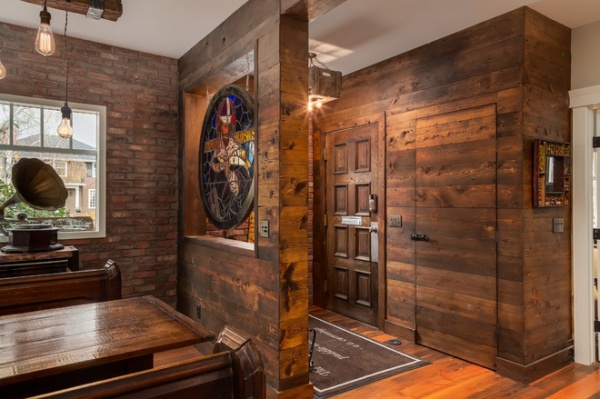
An uncle of Petty’s had given him this stained glass window depicting Saint Ambrose years ago, but they had never found a good place for it in their home. The renovation was an opportunity to give it prominent placement. This partial wall with an opening for the piece helps define the main entry area. The “Batman door” made of matching reclaimed wood is a coat closet.
The couple got really into the design together. Petty got crafty and fashioned the light fixture from a vintage crate himself. After having the basement filled past the brim with water, the couple moved all of the mechanical equipment like the HVAC and hot-water heater up to the first floor. “The basement is dead to me,” McMahen says, but Petty has a woodworking shop down there.
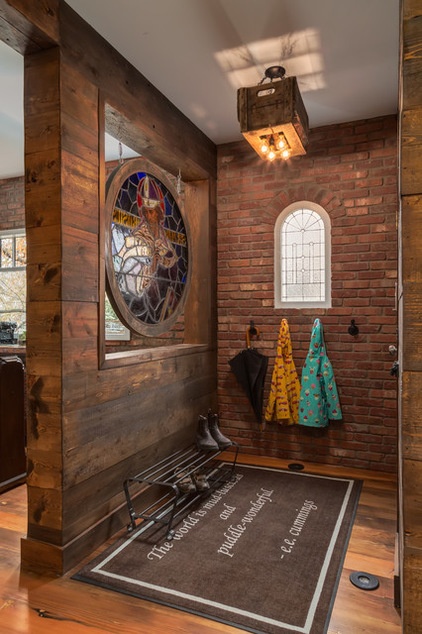
McMahen had the rug made for the entry, and it showcases her funny relationship with water. The E.E. Cummings quotation is, “The world is mud-luscious and puddle wonderful.”
After seeing some of the exposed brick from chimneys in their space postdemolition, the couple got excited about adding the look to the first floor. The walls are veneer made from slices of reclaimed bricks.
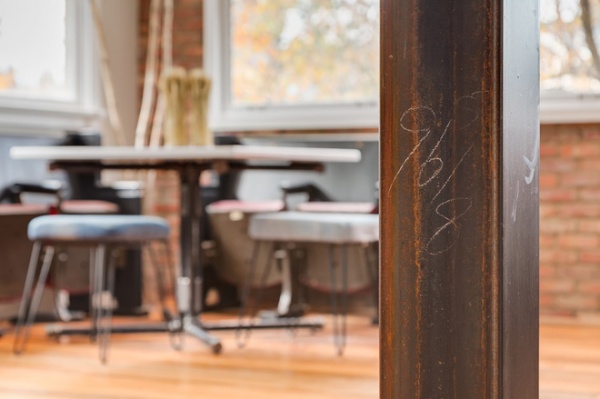
Some of the posts and beams are original, while the contractors added others for structural support where the load-bearing walls had been removed. McMahen had the high-water measurement, 9 6/8 inches, scratched on the beam during the aftermath and sealed. “I had them treat it like an artist’s signature,” she says.
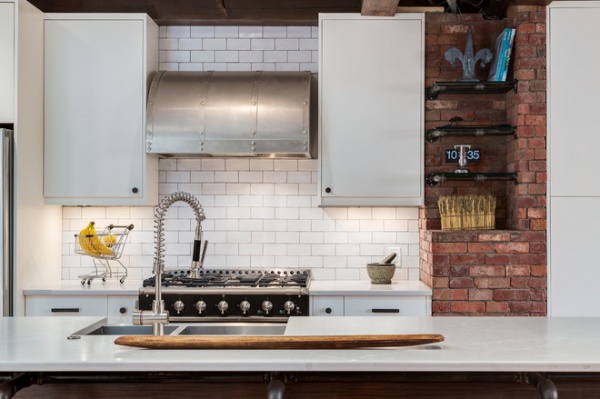
Industrial elements create cohesiveness between the kitchen and the rest of the open space. Local fabricator Custom Stainless & Sheet Metal crafted elements from steel plumbing pipes with a finish similar to those on the steel structural posts. Here you can see them on the shelves and the structural system that attaches the bar stools to the island.
The stainless steel vent hood is a custom piece that plays off the appliances. The subway tile and gray grout provide a clean, no-nonsense, industrial look that contrasts with the dark wood and steel. The black and stainless La Cornue range fits in with the steel details throughout the space.
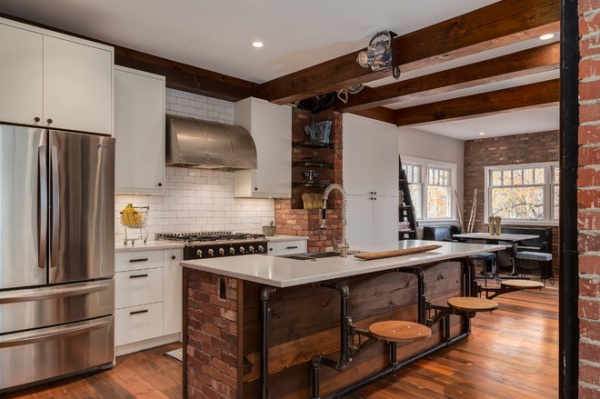
The custom island is composed of the pipe system, reclaimed boards that match those used in the entryway and the same reclaimed brick veneer seen throughout the space. The counters are quartz, which provides a contrasting clean white look.
Not interested in the popular three-pendant-lights-over-the-island look, the couple sourced vintage lights from England.
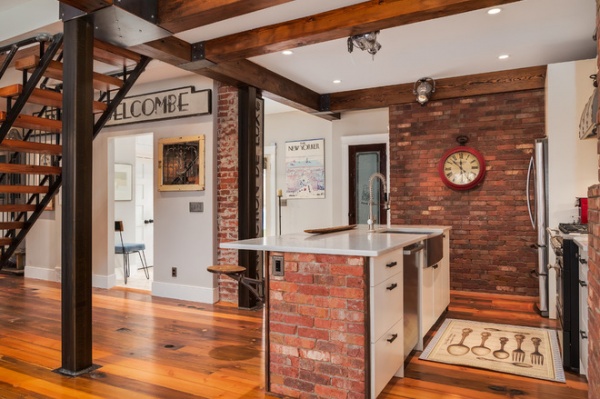
Several reclaimed signs serve as large-scale decor. The one seen here says “Atelier Delcombe” and adds a splash of graphic art deco style. Beneath it is a pub mirror from England. The door beneath the sign opens to a tiled entryway leading to the deck. The area also includes a utility room that houses the mechanical equipment that was formerly in the basement.
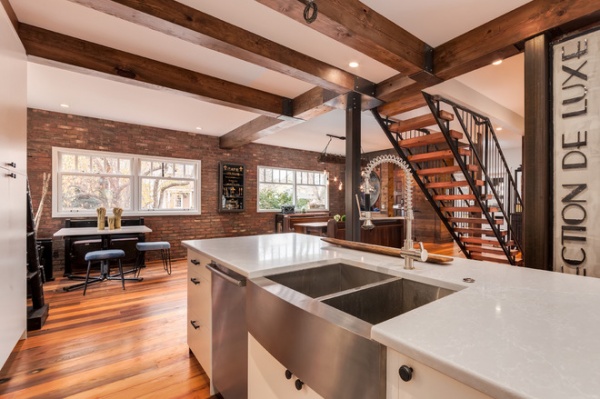
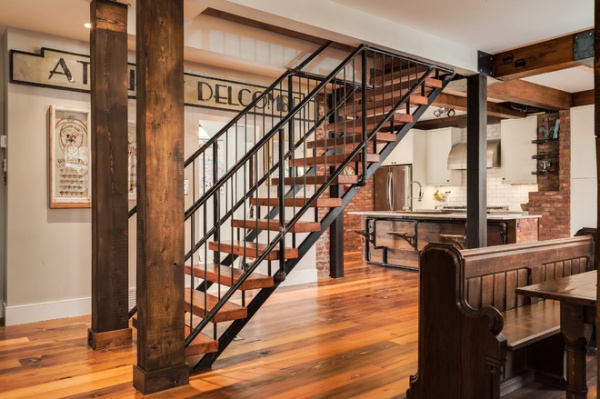
The staircase railing is fashioned from the same type of pipes seen in the kitchen. The fabricators crafted the rest of it from steel stringers and reclaimed-wood treads. The metal straps on the ceiling beams are new. “Whenever the contractor showed us something that needed covering up, we told him, ‘Just put metal on it,’” McMahen says.
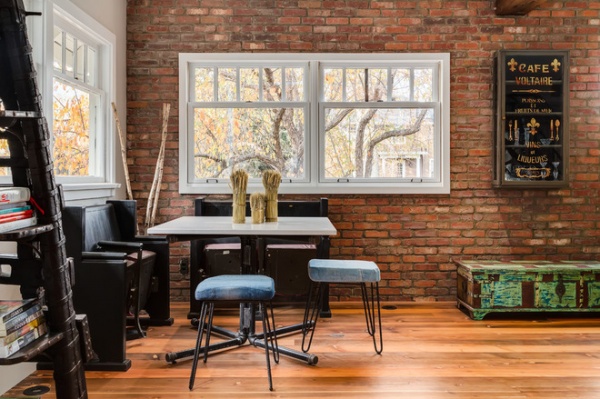
Just off the kitchen is this more casual eating nook. The benches are vintage synagogue benches with seats that flip up and down. The hairpin legs on the stools work well with the black steel; their tops are upholstered in durable denim. Custom Stainless fabricated the table with a steel-pipe base and a quartz top that matches the kitchen counters.
Despite the church pews, a saint rendered in stained glass, a monastery table and synagogue benches, the couple was not looking to make a deliberate religious statement; the furniture they were drawn to just worked out that way. Some of their friends call the first floor’s style “very church basement.” McMahen and Petty are amused by the comments. They are thrilled with the look and plan to keep it for many years to come.
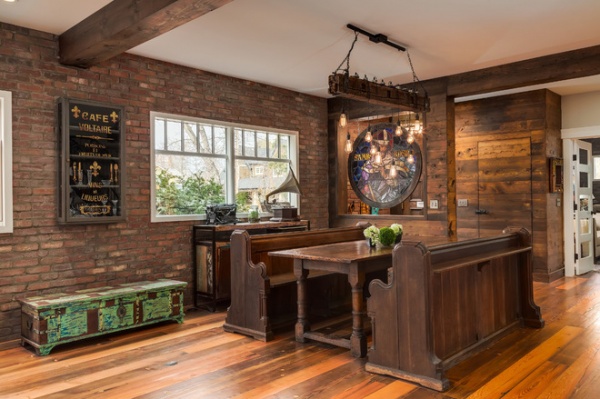
The vintage display case hung on the wall holds crystal and came from a French café.
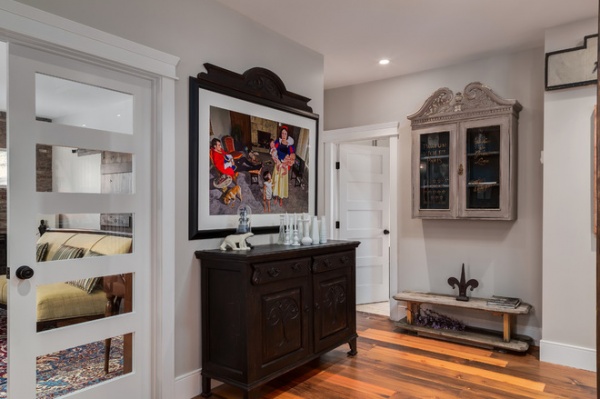
At the bottom of the staircase, a photograph from the “Fallen Princesses” series by Dina Goldstein adds a rare big splash of color. “It’s hilarious — it’s Snow White with too many babies and a crappy husband,” McMahen says. She topped the framed artwork with a piece from the top of the sideboard below, tying the contemporary work to the antique.
The artwork was sold out at the size the couple wanted; the artist suggested that her ex might want to sell his, and he did. “Even this artwork is kind of reclaimed — we reclaimed it from the artist’s ex-boyfriend,” McMahen says.
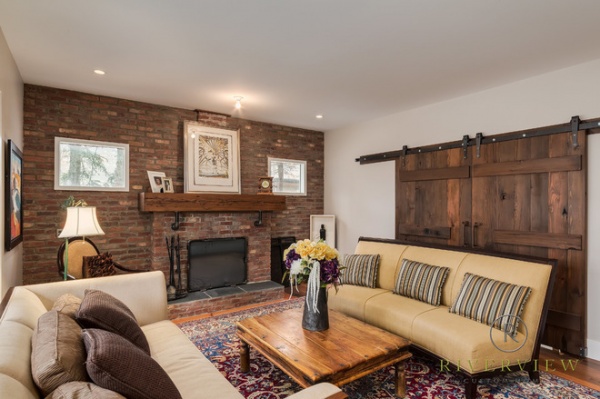
Not part of the open plan, the living room can be closed off from the rest of the house and serves as a quiet room. The TV room is on the other side of the barn doors. The rustic table is something McMahen thinks may have planted some of the inspiration for the design in her head — it’s made of reclaimed boards and has metal detailing and rivets.
The mantel is held up by more steel pipes. Custom Stainless also fashioned the fireplace screen from the pipes.
Sofa: Bondar’s Fine Furniture; rug: antique
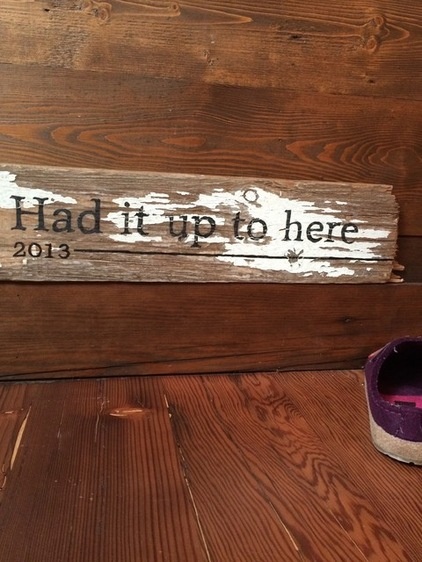
McMahen had these signs made to show the high-water mark in the home and doled them out to her fellow “floodies.” The flood ordeal began with an evacuation on June 19, 2013. After sledgehammering the walls as quickly as possible, weeks of drying out the home with heaters, removing river silt with shovels and pails and a year of renovations, the family moved back in on August 1, 2014.
McMahen says they are constantly discovering the things they’ve lost. For instance, as soon as it got cold outside, they realized they didn’t have their coats, scarves, hats and gloves anymore; when Halloween rolled around, they didn’t have any decorations. However, she sees the silver lining; for instance, they were also able to “lose” asbestos in the basement during renovations. “It was a real opportunity,” McMahen says. “We are just so happy with it; we were able to do exactly what we wanted to do.”
More: Houzz guides to recovering from floods, mold and more












